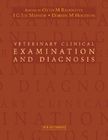The ability to perform a good clinical examination is an essential tool that the practicingveterinarian must possess. Written by leading experts in small and large animal medicine and edited by cattle, equine and small animal experts, this new book provides all the information required to perform a thorough clinical examination of all small and large species, and of all organ systems.
Initial chapters on restraint and handling and information gathering set the scene for the chapters on assessment of individual organ systems, giving the reader all they need to know to reach an accurate diagnosisof all clinical conditions. Handy clinical pointer boxes highlight key clinical information, and many tables and text boxes list important information in an easily-accessible format.
Liberally illustrated with over 240 black and white prints, 38 colour prints and 150 line illustrations, Veterinary Clinical Examination and Diagnosisgives you all the tools you need to examine your patients and reach an accurate diagnosis.
New to this edition
Substantially revised and expanded chapter on toxinsAll chapters fully revised
New quick review synopsis section for complex diseases in Section I of the book, so that key information is easy to findMore didactic style of writing to make for quicker assimilation of key information
Key Features
useful for students and practicing veterinariansfull of clear, informative text on all aspects of examination
over 430 illustrations enhance the text and clearly demonstrate the techniques of examinationhandy clinical pointers give guidelines on key points
written and edited by small and large animal experts worldwide - edited by cattle, equine and small animal expertslarge number of tables and text boxes summarise key information in an easy-to-read style
Author Information
By Otto M. Radostits, CM, DVM, MSc, MRCVS, Dipl ACVIM, Emeritus Professor, Department of Large Animal Clinical Sciences, Western College of Veterinary Medicine, University of Saskatchewan, Canada; I. G. Mayhew, BVSc, PhD, FRCVS, Dipl ACVIM, ECVN, Royal School of Veterinary Studies, University of Edinburgh, Easter Bush, Roslin, Midlothian, Scotland and Doreen M. Houston, DVM, Canada
Section I: Principles
Chapter 1. Introduction and Orientation
Chapter 2. Reaching a Diagnosis
Section II: Evaluation of the Patient
Chapter 3. Clinical Examination Techniques
Chapter 4. Veterinary Medical Records
Chapter 5. Handling and Restraint of Animals
Chapter 6. The Clinical Examination
Chapter 7. Clinical Examination of Dogs and Cats
Chapter 8. Clinical Examination of Horses and Foals
Chapter 9. Clinical Examination of Cattle and Calves
Chapter 10. Clinical Examination of Sheep and Goats
Chapter 11. Clinical Examination of Llamas and Alpacas
Chapter 12. Clinical Examination of Pigs
Section III: Evaluation of Body Systems
Chapter 13. Integumentary System
Chapter 14. Cardiovascular System
Chapter 15. Lymphatic System
Chapter 16. Respiratory System
Chapter 17. Alimentary System
Chapter 18. Urinary System
Chapter 19. Nervous System
Chapter 20. Visual System
Chapter 21. Musculoskeletal System
Chapter 22. Reproductive System
Chapter 23. Mammary Glands














